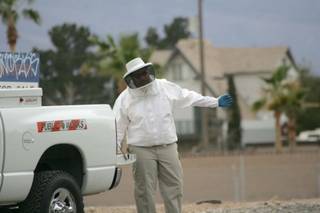
A colony of Africanized bees was disturbed near Spencer Street and Eldorado Lane March 21.
Saturday, March 21, 2009 | 2:51 p.m.
A 53-year-old man was swarmed by hundreds of Africanized honeybees today in a Silverado Ranch neighborhood near Spencer Street and Eldorado Lane.
The man suffered an allergic reaction to the stings and had difficulty breathing as he was taken to St. Rose Dominican Hospital-Siena Campus. He is listed as stable, said Scott Allison, spokesman for the Clark County Fire Department.
He had “hundreds and hundreds of bees stings on his upper body, his arms and his face,” Allison said. “They said that he’s going to be fine, but they are literally having to pull the stingers out one at a time.”
The injured man was operating a backhoe in the yard and disturbed a boulder that covered a large colony, Allison said.
The bees immediately attacked the man, who leapt from the vehicle burning his leg in the process.
When paramedics arrived, the man was shirtless and on his hands and knees in an empty lot adjacent to the house where he had been working.
“When our crew arrived ... they said that his back was literally covered in hundreds of bees,” Allison said. “They said they could barely see any skin. It looked like just a black mass on his back there were so many bees.”
Firefighters sprayed the insects with water to knock them of the man, Allison said. The water flushed off the bees, but many stingers remained in his skin.
A second man working at the home received a few stings but was not transported to the hospital.
Clark County Vector Control, insect specialists, and a private bee expert are at the home.
Africanized honeybees, colorfully known as “killer bees,” are well established in Nevada. The Africanized bee is a hybrid of African and European honeybee subspecies, and neither is native to the Americas.
To the naked eye, Africanized bees appear identical to their European cousins. The biggest noticeable difference is in their behavior.
Africanized colonies are more defensive toward perceived predators than their European cousins. Africanized bees sting in large numbers and will chase an enemy up to a quarter mile.
Africanized honeybees will nest in many places where people may inadvertently disturb them, including buckets, empty boxes, old tires, lumber piles, sheds, garages and openings in or under buildings.
“The guy with Vector Control told us that since 1999, every single bee that they have checked ... has been an Africanized bee,” Allison said.
Experts warn people should keep their distance from the Africanized colonies. If you find one near your home, they recommend having them removed by an expert.
If they chase you, try to get inside and run into rooms, closing doors to put as much separation between you and the bees as possible, Allison said.
“Stay back, call 911 and we’ll come out,” he said. “We’ll call the bee experts and let them handle the situation.”
Correction: This story was corrected to reflect that bees in the wild live in colonies, not hives.
Jeff Pope can be reached at 990-2688 or [email protected].


Join the Discussion:
Check this out for a full explanation of our conversion to the LiveFyre commenting system and instructions on how to sign up for an account.
Full comments policy